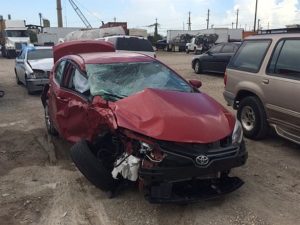It’s the nightmare scenario for any new car buyer. You drive it off the lot and a few days later another driver runs a red light, smashing into your car and severely mangling most of the front end and irreparably damaging the frame – essentially totaling the vehicle.
Luckily nobody was injured, but will insurance cover the total loss? Are you expecting the insurer to pay off the loan and you can be on your merry way? That may not always be the case.
Since the other driver was at fault, their insurer will be the one picking up the tab for your vehicle and, as repairing it is out of the question, it will have to pay you for the damage.
 But, if you only put a little bit of money down when taking out a loan on the car, you could end up having to pay off at least some part of the loan balance that’s left over after the insurer pays you for your vehicle.
But, if you only put a little bit of money down when taking out a loan on the car, you could end up having to pay off at least some part of the loan balance that’s left over after the insurer pays you for your vehicle.
One of the issues that arise is that new cars depreciate in value immediately after they are driven off the lot. If you’ve had the car a short time, the insurer will deduct the mileage from the purchase price and pay you that replacement value of the car at that time. If that’s the case, you should be able to pay off the loan without being out of pocket.
However, if the car is a few months or up to a year old, and you didn’t put a lot of money down, you could be out of pocket. How much will depend on the loan terms (interest and length of loan) and how much you put down when you purchased the vehicle.
Since the crash was the other driver’s fault, their insurance company will pay you the current cash value of your vehicle. The loan is not a consideration for the insurer.
There is one way around this conundrum called “gap insurance,” but you would have had to set it up in advance.
This kind of coverage is ideal for people who didn’t put much money down on their vehicle and/or have a loan that may stretch out for six or seven years. With payments on such a long horizon, you could be in a situation of owing more than your car is worth during the first few years of the loan.
Gap insurance is a special endorsement you can buy for your auto policy which will pay the difference between what you owe and what the vehicle is actually worth. This endorsement was created as vehicles became more expensive and loans became longer.
With gap insurance, the carrier pays the cash value of your vehicle, and then pays off the loan. So if the at-fault driver’s insurer pays you the value of the car, your insurer would step in to pay off the loan.
If you don’t have gap coverage, you will be left with part of a loan on a vehicle you no longer own – and you’ll be without a vehicle. In some cases, the balance of your own loan can be tacked onto to a new loan that you take out for a replacement vehicle.











